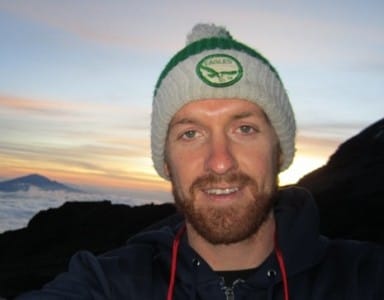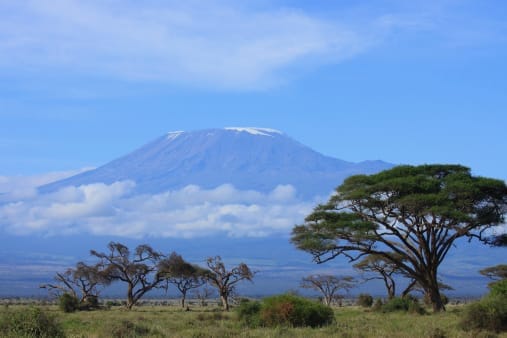On July 2, the cancer survivors turned mountaineers on Mount Kilimanjaro broke into three groups and set off at different times. The first and fastest group, which included trip organizer Mike King, WG’10, surmounted the peak and came down in time to cross the path of group number two. King joined them for their ascent. After completing their climb, the descending group again passed the climbing group. The third group—the slowest group—included Mindy, a bone-cancer survivor who had her leg amputated at 14 and now wears a prosthesis. This third group still faced the toughest last 300 feet of elevation, where oxygen grows scarce and slippery snow cover is common.
King and tour guide Chris Warner went down the mountain, with the second group, to monitor people there. Mindy’s group went on.
About 14 hours into their climb, this third group lost walkie-talkie contact with Mike and camp. Concern set in. Porters took off up the mountain to evacuate the group if needs be. Another two hours passed. King and a “massive” number of Survivor Summit participants and others at camp huddled around the walkie-talkies, waiting for contact.
Then it came: word that the third group had made it.

Mike King, WG’10
“And the place just went nuts,” King recalls.
This is the first time since summit day that he spoke to anyone about this memory, he tells us more than six weeks later. Just remembering the camp that day, the nervousness and then the elation, still chokes up King.
“I felt so accountable for this trip,” he says.
When Wharton Magazine last spoke with King (“Bound to Survive” in our Spring 2012 issue), he had just gotten Survivor Summit off the ground, in large part to honor his father (Wharton instructor Paul King who is battling prostate cancer), and was in the midst of planning the Kilimanjaro trip. The goals of the nonprofit are to provide hope to cancer survivors, their caregivers and family; to eliminate the stigma of cancer; and to raise funds for Lance Armstrong’s LIVESTRONG charity. Oh, and to provide life-changing expeditions.
They seemed to succeed on all counts. All 17 summit participants made it to the top.
As for life changing, that is how King describes the experience. Warner, a veteran guide who operates Earth Treks, puts it this way in his blog, “Kilimanjaro: A Climb for Cancer”:
“A trip like this offered what I now look for in expeditions, a chance to transform lives. Judged by the tears shed, I know that this team succeeded,” he writes. (Also check out the photos and links from individual participants in Warner’s post.)
King also reports that the inaugural trip raised $230,000, as well as lots of publicity. Stuart Scott, the ESPN sportscaster and cancer survivor, mentioned Survivor Summit during SportsCenter. And Armstrong tweeted about the summit to his 3,649,068 followers and counting.
King is already planning next year’s trip at Kilimanjaro, as well as possibly other summits stateside. If you’re interested, more information will be posted at the Survivor Summit website. In the meantime, see what you could be in for by viewing this video from a 2012 LIVESTRONG Survivor Summit participant.
http://youtu.be/_hB1TQqRIzk&w=530


























